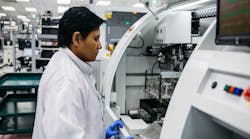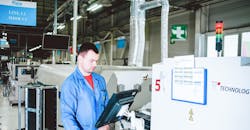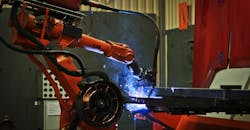With $24 billion in annual revenue and more than 100 global manufacturing sites across 35 countries, Flex produces millions of products daily, ranging from small chargers shipped with mobile phones to room-sized test equipment. Understandably, doing so consistently, competitively, and ethically at the right quality level, on time, and with a very high level of compliance requires the right mix of strategy, processes, dedication, and personnel.
"Flex accomplishes this on a daily basis through its continuous improvement system, which very quickly leads you to automation, especially when parts have a very small form factor," says Flex President of Global Operations and Components Francois Barbier.
As such, Flex has fully automated 60% to 70% of its processes. However, the trend has had little impact on its employment numbers. After all, Flex still employs roughly 160,000 people. "People are crucial in making sure that you have the right processes to automate including programming, maintenance, and real-time information processing," he says. "Progressively, what we have done is upgrade and enable people by training them on different things to do."
Of course, Flex still has manual work where neither automated equipment nor smart robotics thrives. For instance, when starting a new product range, or launching new capabilities in facilities there's a lot of things requiring people. "We cannot replace the flexibility of the human—the movements you're able to do with your body, and what you're able to do with your brain," he says. "Rather than a threat, automation is a ladder to let people get away from boring, difficult or unsafe work, towards more rewarding jobs."
A Strategy That Works
Barbier very much looks at automation from an end-to-end standpoint.
"When thinking about the Flex ecosystem, it starts with the way we interact with our suppliers leveraging a lot of data processing automation," he says. "This is a very important space because before we are able to build any product, we need to ensure we are able to supply all the parts necessary to build the product."
This aspect of automation is something Flex has been working on a lot over the last decade, but even more so over the last five years because the introduction of technical advancements has enabled automation.
The next piece of Flex's automation strategy focuses on the dock-to-dock processes including traceability, receiving, moving throughout the various manufacturing processes, warehouse storage, and then shipping out finished goods.
Fortunately, a lot of possibilities exist, enabling progressive manufacturers to become 70% to 80% automated in this space, explains Barbier. And automation helps in better protecting the people. "Moving goods is always where most safety issues occur, and we have a very high level of demand to make sure that we protect our people and always do the right thing for them," he says. Ultimately, automation has enabled Flex to realize much better results in terms of safety.
The next component is automating the front-end process, which at Flex is building the electronic heart of many Flex products. "Approximately 90-plus percent of our products have these subassemblies, which is something we started to automate probably 25 to 30 years ago," he says. "These people are now able to focus more on delivering close to zero defects, and that's very important because the reliability and the quality level required for electronic goods is very sensitive."
Examples of why the dedication to zero defects is important to exist in every industry Flex serves. Consider, for instance, the growing trend towards driver assist vehicle systems—no one wants to sit in an empowered car with an electronic problem. Similarly, within the medical field, a product tasked with maintaining a patient's glucose level needs to maintain its accuracy.
Flex is also working on automating the final assembly and the testing of its products, an area Barbier openly notes as much more difficult. "When considering the interaction between automation, robotics, and people, this is probably the area where we are in the middle of our journey," he says. "It's good news because the diversity of our products, including the fact that you also need to return the right level of investment on what you're doing in terms of automation. You do not go too far, too quick into complete automation."
When automating, part of the challenge is that Flex often builds products it does not necessarily own the design for. "As such, we need to keep a certain level of flexibility. A product may not be well designed for automation. Or more importantly, if a product is going to change consistently, automation adaptation is difficult."
Avoiding Automation Mishaps
Many companies lack a high level of skill in terms of building automation, and unfortunately tend to outsource too much of it, explains Barbier. "You need to have a high level of knowledge and expertise inside your company to effectively automate your processes," he says. "When buying equipment from outside your company, you need to make sure that you have the right level of understanding, and the people are able to embrace the changes."
Barbier also stresses the importance of having a full plan in place around transforming people who have been working with the manual process, including how they're going to see themselves working with the new process. "Flex, fortunately, was growing very much over the last few years," he says. "When you are growing at the same time you are automating, you're able to redistribute your people and remove the fear that people are going to see a job replaced by equipment."
Bottom line, the key is to have the right expertise to manage the journey, while making sure people are embracing the new processes, knowing they will have a new job that's going to be complementary to what is being implemented.
"It's so very important to involve people. The mindset we have implemented at Flex helps people understand we cannot stay static because we can always do it in a better way tomorrow, which includes automation," Barbier says. "This includes getting their input and allowing them to help with the design, so they feel they're part of the journey. They actually have a stake and are actively involved in it. Every day we need to have new ideas on how to do things in a better way. Always striving for better quality and economical results."
When people come together in a kaizen event, reviewing and streamlining processes without compromising quality, it quickly becomes a mindset that evolves into a culture. Flex has reached the point where the drive is often from the shop floor—not only the idea, but the capabilities to accomplish the goals. "It is a direct result of the lean culture we have been building," says Barbier.













